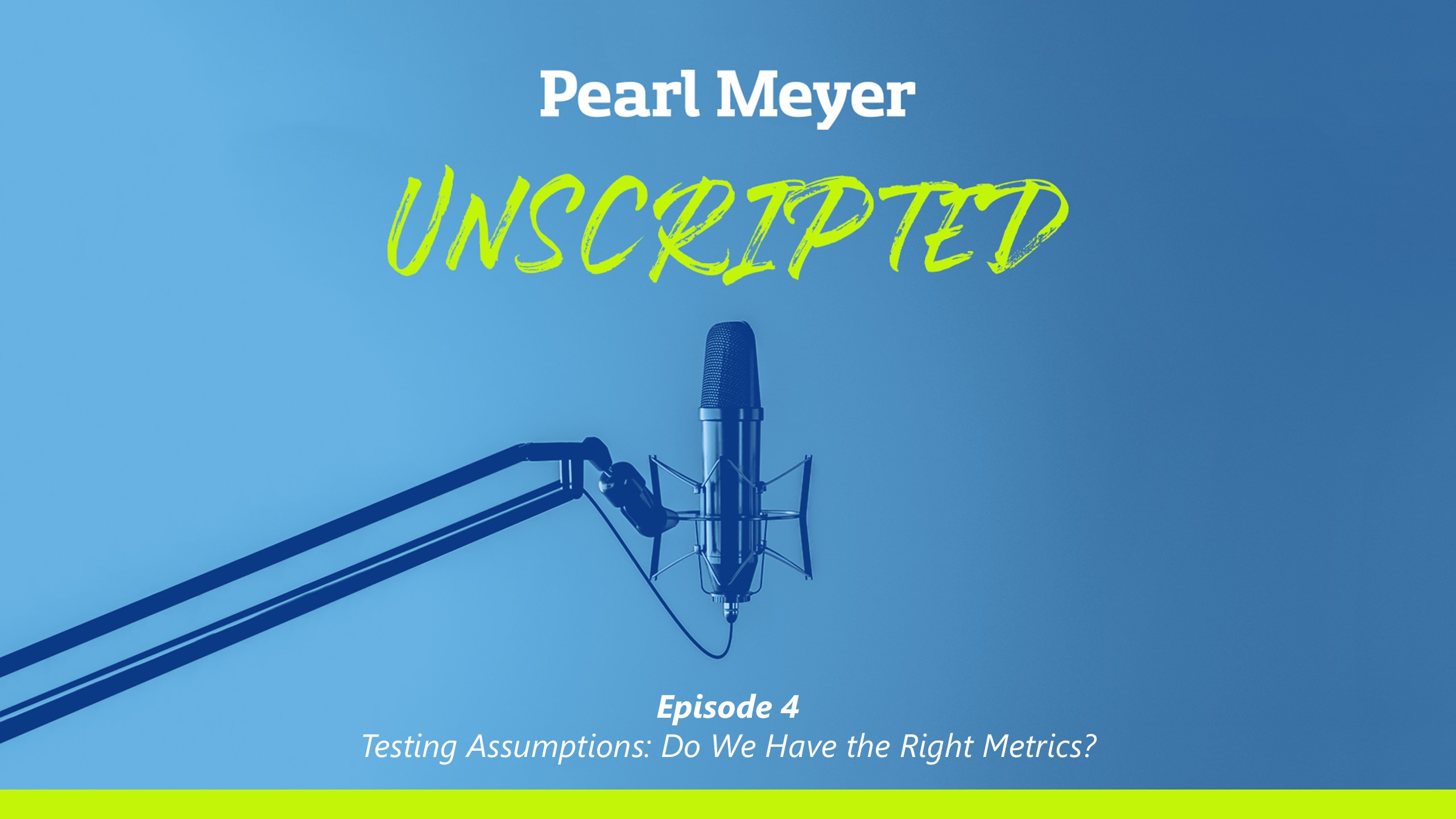
Podcast | Jun 2025 | The Pearl Meyer Unscripted Podcast
Testing Assumptions: Do We Have the Right Metrics?
S1 Ep4: A conversation on relative metrics, and the merits of correlation analysis to understand if your pay program is aligned to long-term value creation.
Transcript
Jake: Do your executive incentive programs deliver on sought after performance outcomes? Welcome to the latest episode of Pearl Meyer Unscripted. I'm Jake George, CMO at Pearl Meyer, and my colleagues, Aalap Shah and Mark Rosen dig into this critical question that almost every board asks. Today, they offer some clear ways to evaluate and reflect on performance and pay outcomes.
Aalap: Hey, Mark. Remember the last time I asked if you had some time to talk through a question from a client. Hopefully, this is a good time, I have some ideas on how to respond but would love a sounding board just to talk it through. So just to remind you, the question was, how can we truly tell if our incentive programs are delivering on the performance outcomes we seek?
Mark: Man, how about an open-ended good question. Don't we get this from boards at every meeting? I think you have to think about it from both a big picture perspective and then on each metric rather, at a granular level. It's always good to look at in retrospect, was performed at commencement of what the payouts were. But I think also you need to look at some relative metrics and ultimately what was realized by the participant both from the annual plan and the long-term. What have you done so far?
Aalap: Really, nothing get at. The question just came in. One of the things I was thinking about was the incentive outcomes and testing against relative metrics. What do think about that?
Mark: Well, do they have a relative TSR plan? Because that's obviously the easiest one to take a look at.
Aalap: Yeah, no, currently it's not part of the program design. We've debated it, but we've sort of not put it in. But I was thinking that what we could do is, even though it's not a formal part of the incentive program, it's a good way to sort of test if the incentive program is actually delivering on the outcomes of the shareholders that you want to see.
Mark: Yeah. So certainly, you can see, certainly relative TSR really does bring into play the shareholder experience because the executives are going to get paid based on that. But I think it's more important to take a look at those financial metrics and say, how did we do compared to our peers? I've got some clients that have some actual relative metrics but the vast majority of my clients don't. But we do like to take a peek at, how did we do with our EBITDA growth? What was our revenue growth compared to others? How did we utilize our valuable shareholder investment? And so with more capital intensive companies, we'll look at return, return on capital employed, return on invested capital. But you always have to be really, really careful when you look at relative metrics. Number one, is the peer that similar to you? Are they in the same business? Are they in the same geographies? But also, look at their balance sheet because there's a bunch of accounting issues that could come into play. For example, if they recently and even not so recently made a large investment, maybe a large acquisition, their invested capital could be artificially higher because they had to mark that asset to market and their return metrics will always be lower than a company that had not made a large acquisition. Of course, it always depends on what the balance sheet looks like but just be aware of those sorts of things.
Aalap: Yeah, I run into that problem often when thinking about relative financial metrics, is that, are the definitions that the companies are using, are they similar enough that we can get good data from? So I think that is a great caution, not only to look at potentially one-time events that might be impacting the financials, but also just from a definitional perspective, can you create a consistency in order to measure on a relative basis. But I think what I'm going to do in one of the responses I'm going to say back because it could be a good way to introduce relative TSR back into the conversation, is to look at not only relative financial metrics, but relative TSR as well. And then depending on the result, that might give an entryway to introducing relative TSR as a modifier long-term program if this is a continuing concern.
Mark: Yeah. Have you done any correlation analysis to look at their actual financial metrics and how that historically has related to value creation?
Aalap: Yeah, funny you should say that. You know, when we first started working with the client, we did do that. It was one of the reasons that they wanted to work with us is that we stated that we would want to test their performance metrics and see if they're actually correlated to value creation. But what's interesting we did it once when we started working with them, but we haven't done it, you know, again, and it's been a few years. I think testing whether or not the actual performance metrics relate to value creation either through total shareholder return or, you know, market to book ratios, it might be good to see if the performance metrics, given that the business has morphed over time, you know, are really still the right metrics.
Mark: You know, that's interesting because I work with a lot of industrials that it's pretty clear that EBITDA and EBITDA multiples are where we look to for value and how to value the equity. So it's really interesting to think about what other metrics, especially as an organization changes their business or has different acquisitions or whatever they're doing because it's rather simplistic to just say EBITDA times a multiple.
Aalap: Right, absolutely. And I think maybe this correlation analysis might even surface some metrics that we haven't thought about. And so because I've been aware when I've done it in the past for another client, we had been using EPS for really many years. And when we did the correlation analytics, it was fascinating at how low a correlation ETS actually had to value creation. And so we did revise the program based on that. Obviously, it should only be one input in the decision when you think about performance metrics, but it is something that did surface other metrics that were more meaningful.
Mark: Did you look at your targets and see their robustness and think about a probability analysis, how often it should be attained?
Aalap: Yeah, we're actually doing that right now. And so I don't have the result yet. What we figured was another way to test this, and this was unrelated to the question, we were doing it anyway. But I think it applies is that, have the metrics been robust enough? So think what I'll do is I think I'll expand the analysis to go back in time as well. Right now, we're just testing against the current goals to see if they have that nice bell curve distribution that we like, where the target's about 50 to 60% probable outcome and the superior goal is only about a 10 to 20%. But it might be telling to go back multiple years to test over time, have the performance goals been set at robust enough levels? Because again going back to the original question, are the incentive programs delivering on the performance outcomes that we want if you aren't setting your goals in a sufficiently robust fashion, then you're probably not getting the performance outcomes that you seek. You know, looking at that over a multi-year period, I think, is a good thought. So I think we'll extend that analysis.
Mark: Well, as you're thinking about longer term analysis, I think the ultimate check and sort of the big picture check is that realizable pay analysis. As you think about that, and I think the newer, it's not new anymore, but newer cap tables in the proxies, compensation actually paid, which isn't actually paid. But I think it was an attempt to get at this concept of realizable pay, which is over a three or five or even seven year period. For one client, we do it over a 10 year period. What was actually paid to the executive versus what the performance was, whether it's a relative TSR. So how did our TSR compare to a peer group? Compared to their realizable pay versus our realizable pay. And it's important also to recognize the difference between realizable pay and realized pay.
Aalap: Yeah, I mean, don't get me started on the pay versus performance tables in the proxy, but take your point in terms of testing against realizable pay. And so I'd make the distinction, if we were going to do that, I'd make the distinction and focus on realizable pay because I think there's all these in cycle long-term incentive programs that I don't really want to just see what the executive has received, which it would be realized pay, but really sort of make sure I take into account those long-term programs. Would you do that as well?
Mark: Yeah, but let's make sure we're talking about the same thing. So whenever I see somebody say realized pay, it is the actual pay that has been delivered to the participant. So it's, annual incentives that have actually been paid. It's the long-term incentives that have actually been delivered and are no longer in flight. Realized pay tends to ignore in flight incentives. In flight, meaning you're in the second year of a three year plan. But also it takes into account options when they're exercised rather than what is available to the participant. So I've really not liked realized pay, but the beauty of a realizable pay is that you're looking at, at any point in time, how much value has accrued. So for example, an in-flight incentive plan. You would say, where do we stand two out of three years and mark to market, if you will, that incentive, including any changes in the stock price. The same thing would be true of an option. If there's an outstanding option that's unvested, what is the value? What's in the money for those options? And then unlike the cap table, we're not going to run a Monte Carlo valuation on a relative TSR because I find executives don't look at Monte Carlo valuations. They look at the intrinsic value. Where do we stand today? And if the plan ended, what would I get?
Aalap: Yeah, I don't want to get caught up in talking about the valuation assumptions and stuff like that. The idea for this analysis, I think, definitely is to keep it simple and just focus on that intrinsic value. And 100% agree on your point on realized pay, especially with options. Because frankly, that's an individual economic choice, whether you're exercising or not. So that would definitely skew the relative comparisons to peers. So I think you're right, realizable pay is probably the most effective test to answer this board member's question because you can clearly see how the company's performing against peers and assess if the pay outcomes are appropriate given that performance. And when I've done it in the past, what we tend to do is introduce it at a meeting where we are not deciding on pay, but one that is devoid of that sort of decision making, just so you can reflect on, over last three years, five years, 10 years, have we delivered what we wanted to deliver to the executives? And has it been appropriate per the pay outcomes?
Mark: Yeah. And it's going to be highly dependent on stock price because so much of long-term incentive, so much of the compensation is dependent on stock price. But you will also find that, for any long-term incentive plan that is variable. So you could earn 200% or you could earn zero that will play into the ultimate realizable pay.
Aalap: Well, thanks, Mark. I think I have what I need to call back my director. So really appreciate you taking the time.
Mark: Good luck. Have a good afternoon.
Aalap: Take care.
Jake: That's all for today, but it's not the end of the conversation. Mark and Aalap will be back next week with some pros and cons on non-financial metrics. Look for next week's episode on Spotify, Pearlmeyer.com, or wherever you get your podcasts. Thanks for listening.
Look for new episodes each Monday afternoon at Pearl Meyer Unscripted, subscribe to our YouTube Channel, and listen on Spotify.


